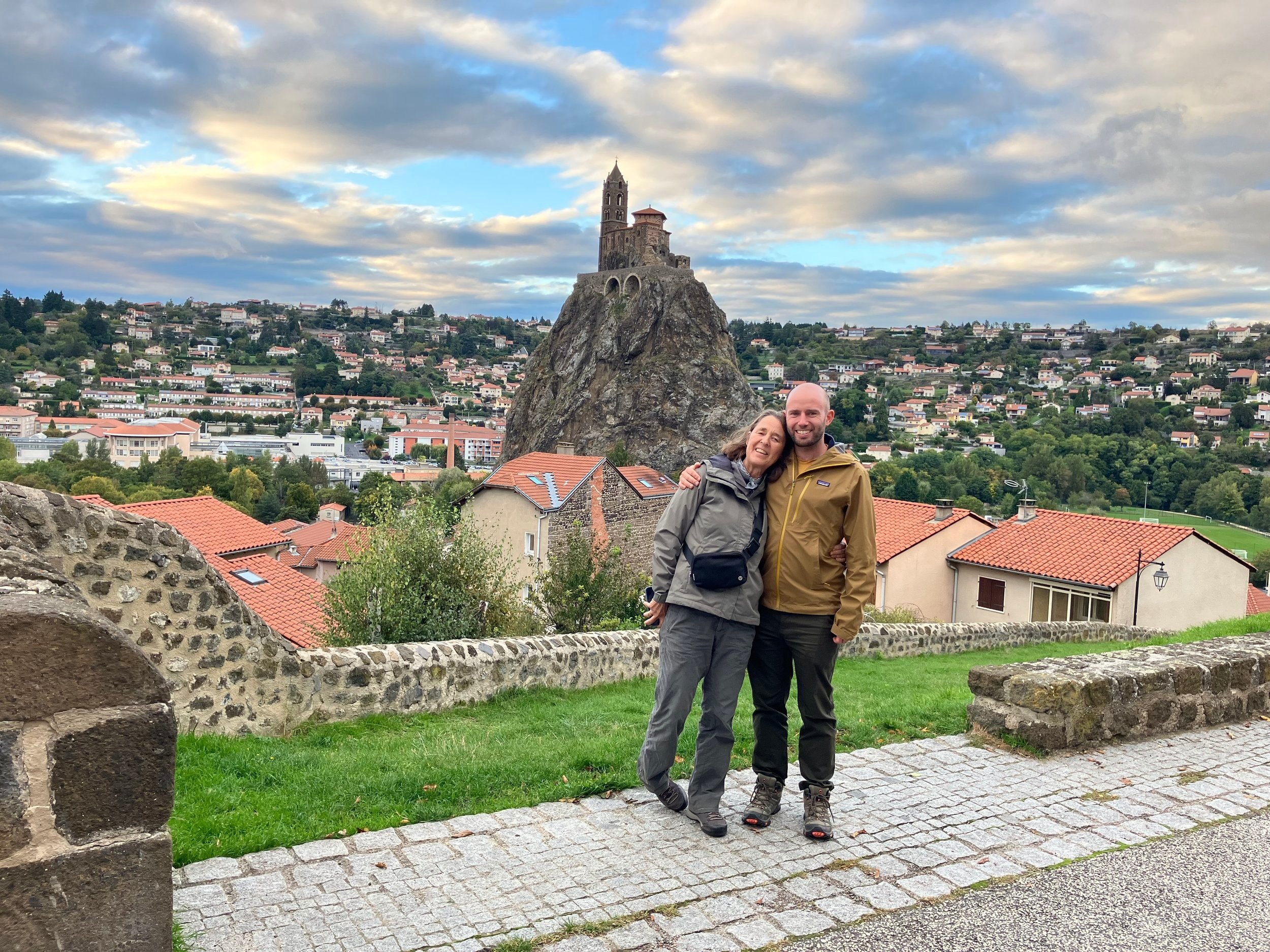Le Stevenson
Sister Becky retired on October 1, 2024 and to celebrate this end of a rich and long teaching life we decided to disconnect her from her computer and head out on a walking trip, or maybe you’d call it a hiking trip through the middle of France. We settled on the Stevenson trail, the secular steps of a secular man, the writer Robert Louis Stevenson, that parallels the religious path of those pilgrims walking toward Compestello. I thought of us as pilgrims as well, walking our way toward a less anxious, and more present life. Stevenson, writing of his journey that set the trail’s route said it well: “When the present is so exacting, who can annoy himself about the future?” So for six days, we had nothing to do but worry about the next step, the next meal, the next bed for the night. And that simple life worked its magic on us, even if we did not walk with a donkey named Modestine. We walked, instead, with Thomas, Becky’s son, who served donkey-like to carry the heavy pack. He was also lead laugher, his laughter carrying us down the trails.
Thomas and me in front of Saint Michel D’aiguilhe
Sister Becky retired on October 1, 2024 and to celebrate this end of a rich and long teaching life we decided to disconnect her from her computer and head out on a walking trip, or maybe you’d call it a hiking trip through the middle of France. She picked the Stevenson trail, planning our route and our nights in gites, following the secular steps of a secular man, the writer Robert Louis Stevenson, that parallels the religious path of those pilgrims walking toward Compostello. I thought of us as pilgrims as well, walking our way toward a less anxious, and more present life. Stevenson, writing of his journey that set the trail’s route said it well: “When the present is so exacting, who can annoy himself about the future?” So for six days, we had nothing to do but worry about the next step, the next meal, the next bed for the night. And that simple life worked its magic on us, even if we did not walk with a donkey named Modestine. We walked, instead, with Thomas, Becky’s son, who served donkey-like to carry the heavy pack. He was also lead laugher, his laughter carrying us down the trails.
Our trip began with a train ride from Paris to Le Puy en Velay where we spent a pleasant night in a 15th century tower and did not rise at 7 for the mass for pilgrims heading west to Finisterre. Le Puy is known for its 12th century cathedral, Notre-Dame du Puy, which has a checkered look with white sandstone and black volcanic rock sitting side by side. What really captured my eye, though was the crazy Saint Michel D’Aiguilhe atop a volcanic plug. The site was closed, but if we had stayed on a day 268 stone steps would have taken us to the church.
The central place in Le Monastier
For the first morning, we turned our sights toward the little village of Le Monastier sur Gazeille, 12 miles away, walking across fields and at times along roads. We rarely strayed far from civilization. We could see the volcanic past in the trail, often littered with basalt, or black with volcanic dust. As we walked, a man pulled up in his car, curious about us and our walk—throughout, everyone along the route was welcoming and friendly (except one grumpy baker). After we answered his questions about where we were from (one from the States, one Parisian, one French man living in Switzerland), we asked our own, mine focusing on the natural landscape (as always). The tree that so puzzled me with its thick, scale like leaves – not the Scots pines, which are plump and blue-green in color and lined much of the trail—was an imported tree that is referred to as the désespoir des singes (monkey puzzle tree). From Chile and Argentina, this is surely not a tree that Stevenson would have seen in his 1878 walk.
We hardly got an early start out of Le Monastier as we set in food supplies for the walk—picnics were important—and admired the stone arches of the village, the lovely stone place where we had spent the night in one of the many chambres d’hotes along the way. On this day, Becky carried the heavy pack to give Thomas’s hips a rest, and we move slowly along the 15.3 miles toward Le Bouchet St. Nicholas, which is a cluster of stone houses (no stores or restaurants that we could see). We walked through fields, up rolling hills, picnicked by the Loire, and in the afternoon when the sun came out, we stopped in a café for an energizing coffee. Still, we were tired and walked the final kilometer holding hands for courage (I admit I was the most tired of the three of us). Because of our meandering pace, we arrived at the warm chambres d’hotes where they served the signature dish of lentils and sausage after all of the other hikers (we were 11 that night). This made us the punters for the night.
Arriving (late) in Le Bouchet
Because all of the walkers or hikers move south, dutifully following the yellow signs that read “Le Stevenson” or the red and white blazes on rocks or trees, we rarely saw anyone during the day. At night we could chat with other hikers, like the retired Welsh couple who hike all of the time and who offered me arnica to help with the hip pains. We crossed paths with them again the next day but there was little sense of community; even the hosts of the gites or chambres d’hotes along the way only spend a few short hours with travelers.
We were once again the last to set off in the morning, heading toward Pradelles. Keeping at least a decent pace—I’ve never been a fast walker—didn’t make for great bird watching but I kept my binoculars near to watch skylarks tumbling over a field, a kestrel hovering, and a gray heron poised beside a stream. Stevenson describes little of the natural world in his narrative, though comments on the birch and the beech trees along his route and I noted them as well, like we might have admired the same stout trees.
Pradelles is declared one of the prettiest towns in France. Our hotel was not so pretty and sat hard on the route national that roared through town. In the morning we wove our way through the narrow cobblestone streets, but the possible sweeping views from the walled village were clouded over, fogged in. Our path took us to Langogne, one of the biggest towns we crossed and out to the Lac de Naussac. On our trek to the lake we overtook an elderly woman, galoshes on, hunched over but walking determinedly uphill. She stopped and smiled at us and told us that she was off to gather mushrooms. It’s a way to pass the afternoon, she explained. The days of damp, warm weather meant there were a lot of mushrooms along our paths, those you want to eat and those you want to avoid. We wished her good luck, waved cheerfully, and continued on our detour from the trail to stay in a modern cabin by the lake—a rest day that involved only nine miles of walking. As we made a final turn a car pulled up next to us. “Are you walking the Stevenson?” They asked. Yes, we cheerfully replied. “You know you are not on the trail, right?” Yes, we cheerfully replied. So now we were the punters who looked lost.
Becky admiring the town of Pradelles
During the night there was a storm for the records, lightening lighting our rooms and thunder shaking the cabin. This was perhaps the most dramatic element of this walk that on the whole traversed a lovely but unspectacular land. There were rolling hills, and gentle streams, swollen by the rain. But even the Loire at this point in its journey is an inconsequential stream. There were contented cows and dense woods. Open fields. Adorable, sleepy towns that felt shuttered and at times perhaps too quiet. The variety of this cozy landscape was enchanting. The storm, though, was breathtaking.
The next morning we bid goodbye to Thomas, who needed to get back to real life. We loaded him with everything we deemed unnecessary and tromped off with much lighter packs if with heavier hearts. Also, we had to figure out how to take decent selfies. This day out of Langogne to Les Hauts de Cheylan was perhaps my favorite day of hiking. The trail was wide, sandy, rolling. It no longer hand a volcanic feel. At times I looked at a wide field with tall pines in the background and thought: I’m in Colorado. There was a great sense of light and space. It helped that the sun came out.
Hike through a forest of pines Stevenson might have also have seen
Our final day we vacillated: would we be super punters and take a bus from Luc to La Bastide-Puylaurent or would we push through and walk, possibly our longest day. By this point, I felt broken in, and eager to hike, and Becky still voiced no pains. So we walked, traversing dense woods where people searched for mushrooms (the mushroom frenzy was real), looped around a pond and stopped to picnic near a castle. After Luc, the trail followed a major road too closely and so lost a bit of its charm. But maybe that sense of “not-pretty” was because the overcast sky that had kept us company all morning unleashed its pent up emotions. Or, as Stevenson would say, “the wind freshened into half a gale, with a heavy discharge of rain.” That wind whipped us up and over a mountain, and a little soggy into the small village of La Bastide-Puylaurent where we settled into our grimmest hotel of the voyage. It didn’t matter. We played cards, ate well, and felt a twinge of sadness as the next morning we boarded the train to Nimes, then on to Paris.
Stevenson’s narrative is filled with information on religious wars, especially the conflicts between Protestants and Catholics that dominated this part of France. We had not one religious conversation through our walk. But mostly, Stevenson’s narrative is centered on his relationship with his donkey Modestine, who is an unwilling walker (and, we learn from one of our hosts, though people still do the walk with donkeys, donkeys really should not be expected to walk more than 15 km a day—Stevenson was pushing Modestine, often cruelly, beyond her limits). Stevenson revels in his time alone with his donkey, describing how he surrendered “himself to that fine intoxication that comes from much motion in the open air, that begins in a sort of dazzle and sluggishness in the brain, and ends in a peace that passes comprehension.” Well said my swashbuckling writer. (If you have not recently read Treasure Island—do. It’s just great fun.)
Becky peering into the ruins above Luc
Like Stevenson, we put one foot in front of the other, ate well and a lot, stopped to photograph rolling hills and a crumbling castle or two. By the end, like Stevenson, “my blood flowed with [the] luxury of [it all].”
Wood Pile
Through the winter months when my friends are going to the gym, taking yoga or pilates, I’m cutting wood. It’s my gym, my church, my movie night. Last year I had a few trees taken down so that from the top of the ridge where my house perches I have a pocket view of the Catskill Mountains. I felt badly about cutting what were mostly beech trees, so like the hunter who decides to take a deer and eat every part: heart, liver, thighs and knees, I decided I should use this wood. The difficulty is that these trees are down a hill and all I had was a little handsaw.
I cut my logs about eight inches in diameter, and about 36 inches long (it is never, however, this precise). This part of the cutting is the most satisfying, a sort of meditation on an outsized game of pick up sticks. What will drop easily? What will I have to support, and what will fall if I take this piece here? I pile these in one place and carry them up the hill. It was during this phase that a young friend, Remi, pointed out I should be using a better saw. A little research later and I had a Silky Katanaboy, a work of art that slices through wood like butter.
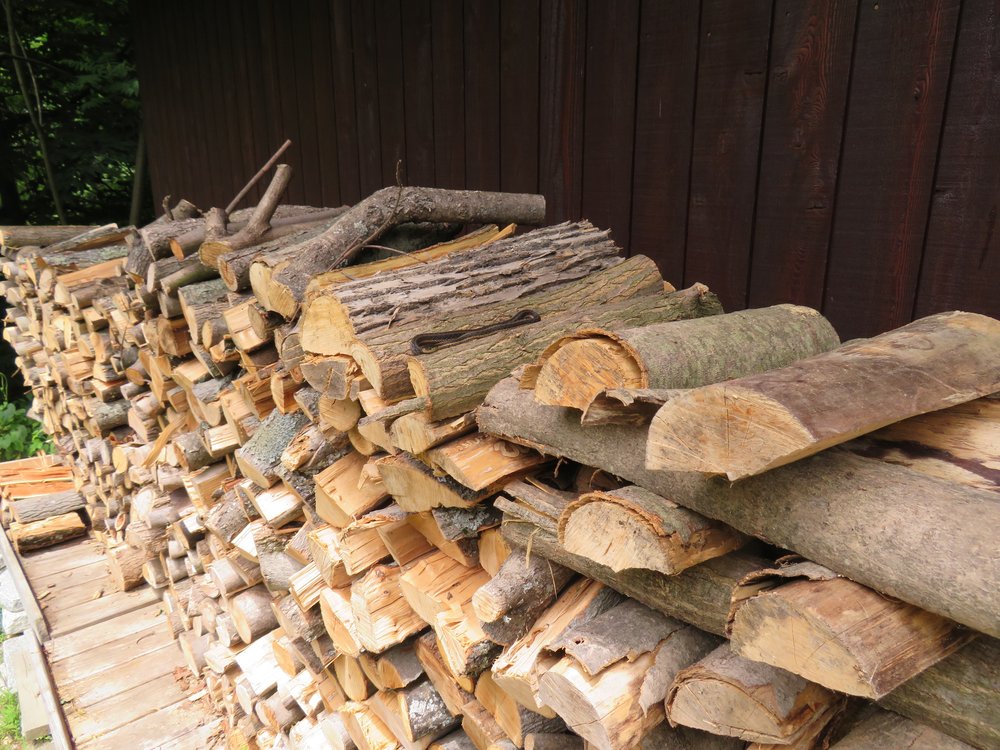
Through the winter months when my friends are going to the gym, taking yoga or pilates, I’m cutting wood. It’s my gym, my church, my movie night. Last year I had a few trees taken down so that from the top of the ridge where my house perches I have a pocket view of the Catskill Mountains. I felt badly about cutting what were mostly beech trees, so like the hunter who decides to take a deer and eat every part: heart, liver, thighs and knees, I decided I should use this wood. The difficulty is that these trees are down a hill and all I had was a little handsaw.
I cut my logs about eight inches in diameter, and about 36 inches long (it is never, however, this precise). This part of the cutting is the most satisfying, a sort of meditation on an outsized game of pick up sticks. What will drop easily? What will I have to support, and what will fall if I take this piece here? I pile these in one place and carry them up the hill. It was during this phase that a young friend, Remi, pointed out I should be using a better saw. A little research later and I had a Silky Katanaboy, a work of art that slices through wood like butter.
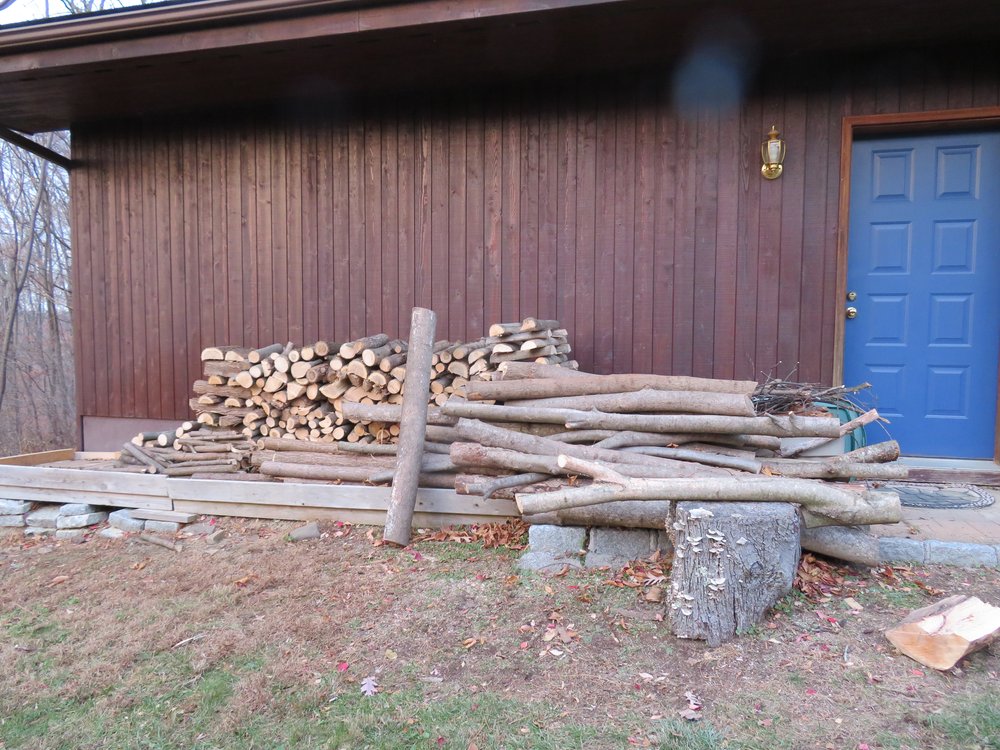
Once my lengths are cut, I carry them up the hill. Or in a Tom Sawyer move I get others to carry for me. I am rich in young people in my life, and whenever they visit I say: want to come see my woods? As if it might be the greatest treat. Only I referred to the section of woods where the trees lay for the taking as my elk hunting ground. No one thought this as funny as I did yet still everyone has brushed into the woods with me and hauled his or her share of log
Back at the house, I cut them into three lengths and split and stack. All of this takes time but I found that an hour or more a day (I tried not to let the cutting take over, become a day long obsession, which it easily can) and it starts to add up not unlike writing a book that with an hour a day becomes whole, though with the book it’s less obvious and when I write often I have to take logs back down to the woods. Bring them back up. Return them. It’s a lot less linear. For this, wood cutting, splitting and stacking is infinitely more satisfying.
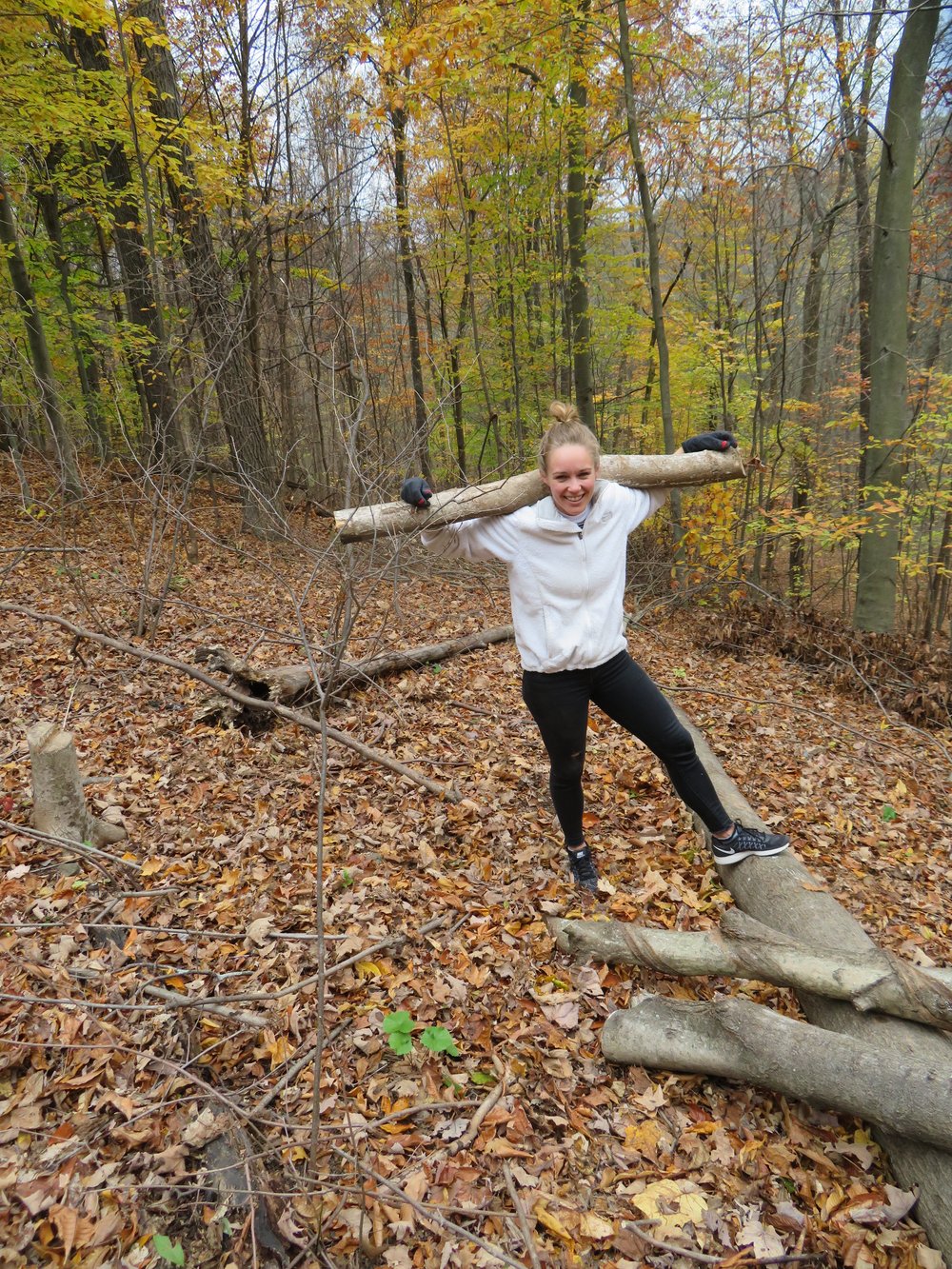
If I have resisted the obsession of cutting, the whole process of my woodpile is an obsession. And it’s not just my woodpile that absorbs my attention. When I drive the back roads of Dutchess county looking for birds I often pull to the side of the road when a particularly beautiful woodpile comes into view. And by beautiful I mean what my woodpile is not: ordered, as if the stacking itself were an art form.
When I write in my journal in the morning, large notebook flat on the wooden table, my grandmother’s fountain pen (yes, I am that much of a cliché of morning journal writing) at the ready, the lines start to drift. Inward. So that the left-hand margin of black ink slowly bellies in, like a gentle bow of a river. My woodpile is similar, only it bellies out, like someone who drank a bit too much beer. A few months ago during one of our many winter storms, it collapsed. A woodpile must rise straight, and I worry that straight lines are not a part of my DNA.
What is my DNA? I can find out, it seems, so easily. But this is what I know from family history. My mother’s father was Swedish, my mother’s mother French. On my father’s side American back through too many generations. Probably British. Is it the Scandinavian in me that wants the woodpile (the Norwegians are obsessed with wood) and the French in me that makes it a messy pile?
In the summer months, this messy pile toasts in the sun. I look at it with satisfaction and friends admire it and ask: why don’t you get a chainsaw? Why don’t I write my journal on my computer, which would be so much more efficient!? Because inefficiency is a luxury and one I love more than a fancy hotel or a four-star restaurant. When I am curating my woodpile I write sentences in my head. I think things like: having a chainsaw is like having a gun; both will go off in ways you don’t expect or want. No matter how careful you are. My inefficient wood time is my greatest solace, my silence, my friend. And there’s a side benefit: I am both strong and warm, all through the winter.
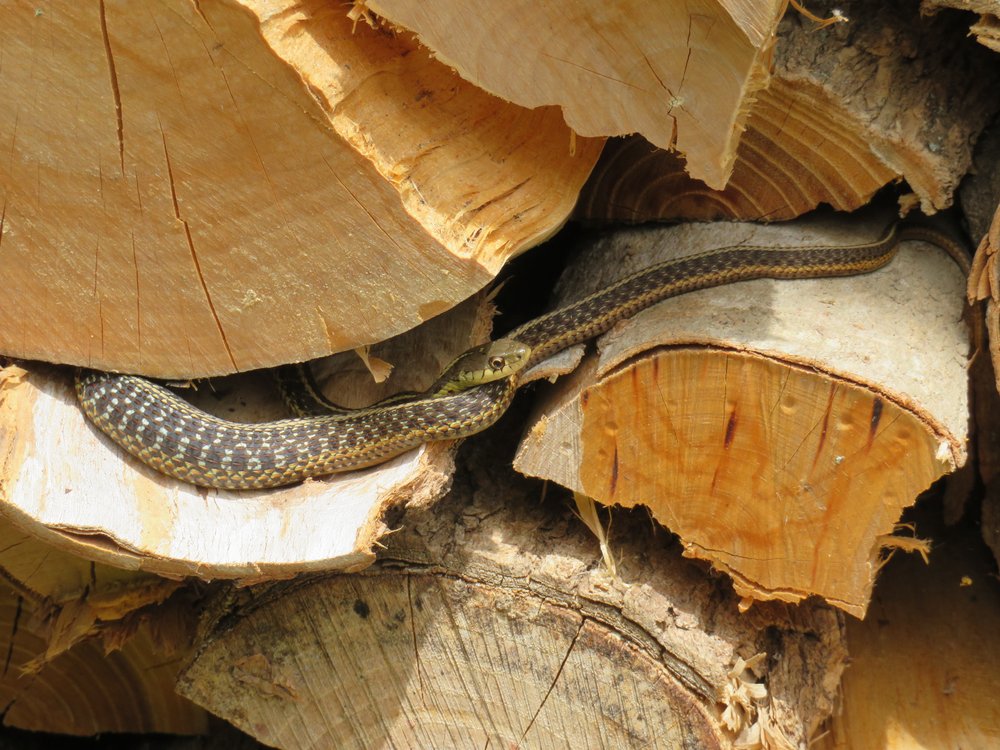
Now in the summer when I don’t need my wood to burn, into and onto this toasted woodpile snakes, sweet garter snakes, have arrived. It looks like a young family, growing, molting, eating whatever dares to trespass into their domain. My messy pile is their castle. And this messy writing is now my first blog post for the summer, a return to writing, I hope about the adventures in everyday life.

